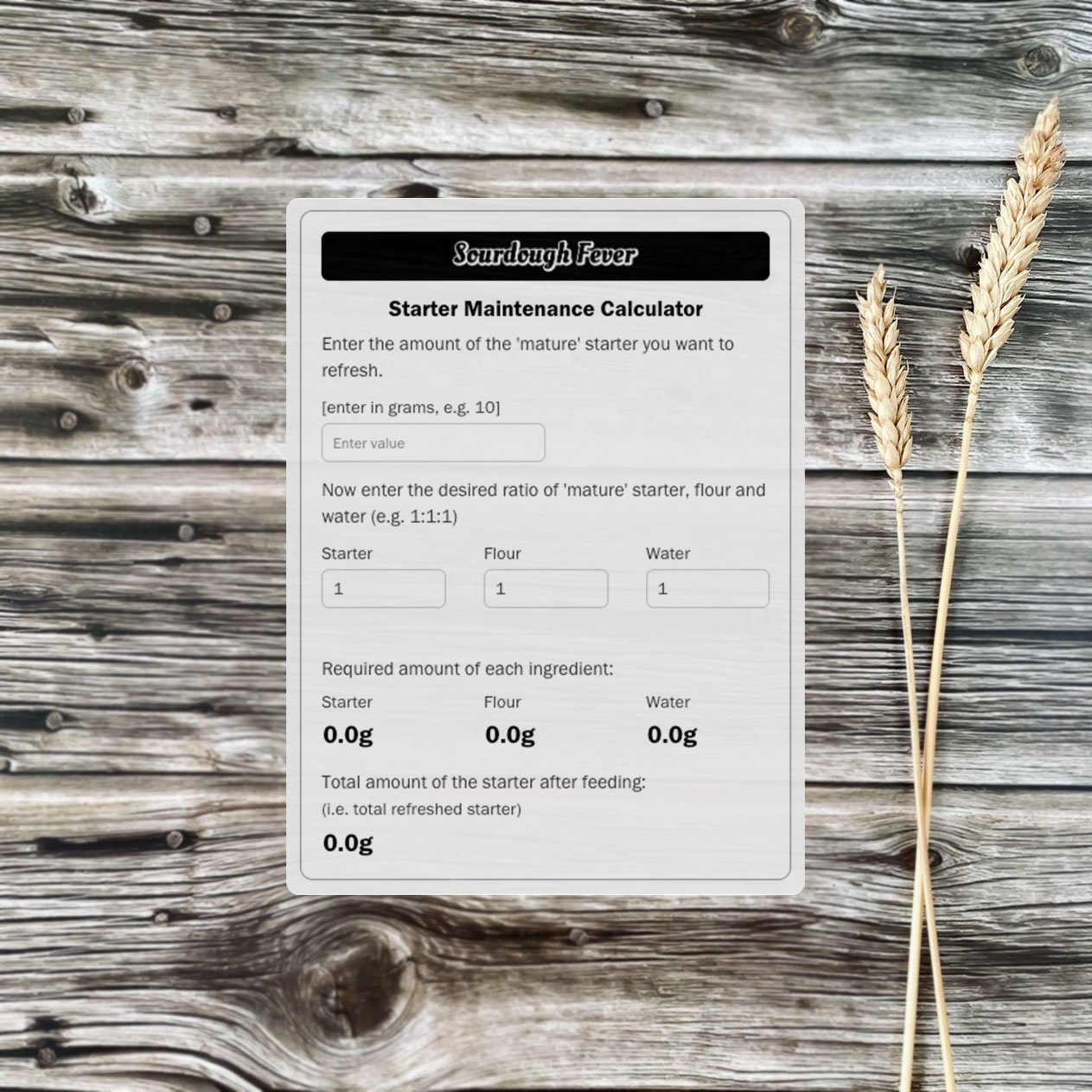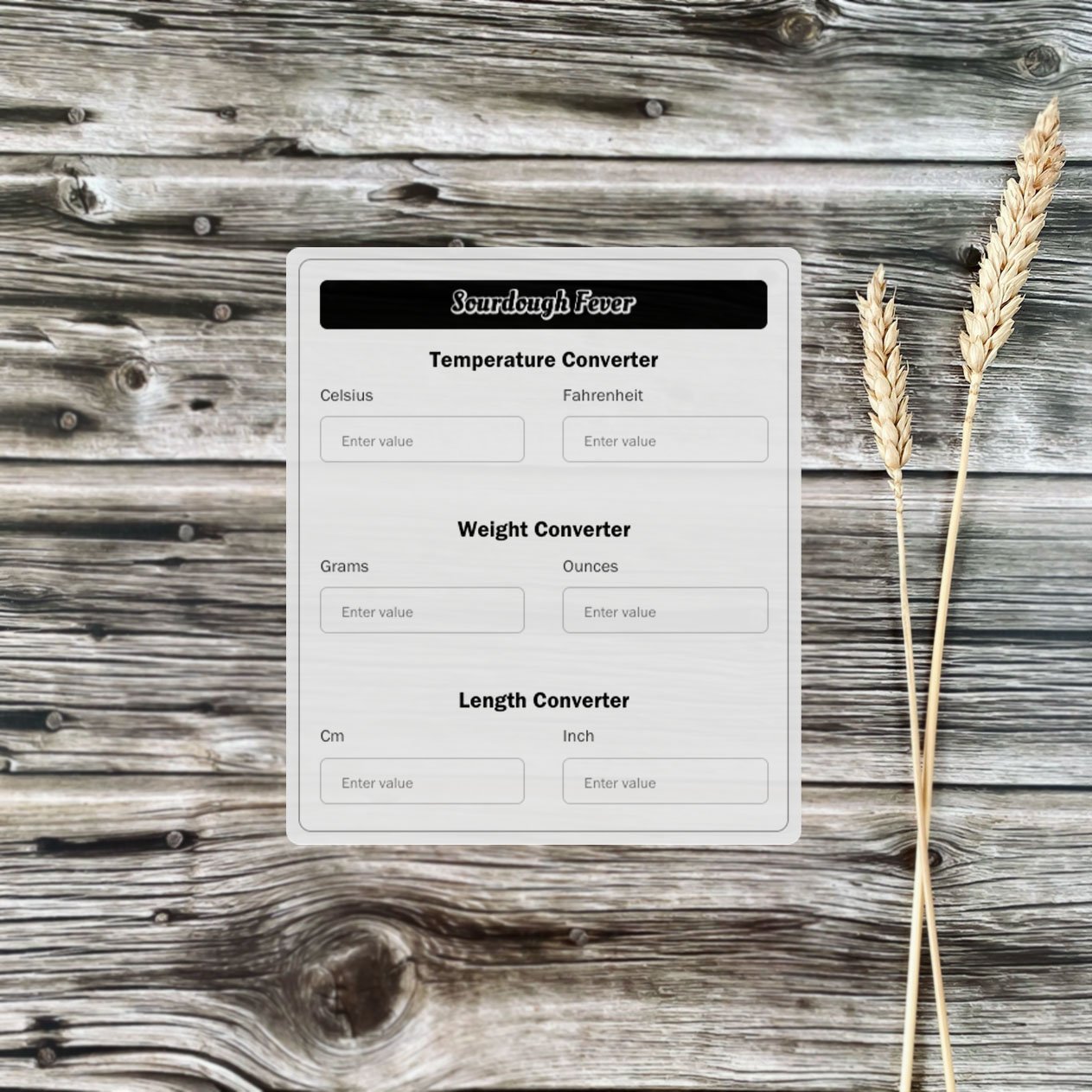Already a Member?
Select your member area below to log in and access the calculators
Basic Plan
Premium Plan
7 Calculators Made For Sourdough Bakers
Baker’s Math Made Easy
We’ve created a set of seven calculators to help with baker’s math, offering a seamless and intuitive user experience. Work out ratios of ingredients in a recipe, dough hydration, scale a recipe and much more!
This is a useful toolkit for both beginners and experienced bakers—helping you work out baker’s math at the various stages of the sourdough-making process.
The calculators can be accessed via a mobile device or computer with an internet connection, and were designed to be both functional and visually appealing while delivering instant results. You just need to become a member on one of the available plans.
Baker’s Percentage Calculator
With our intuitive design, and instant results, you will be able to easily work out grams or percentages of your sourdough ingredients.
This is the one calculator every sourdough baker should have at hand!
-
Baker’s Percentage is a system that bakers use to express ratios of ingredients as percentages. In these ratios, flour weight always represents 100% and all other ingredients are a percentage of the flour weight.
For example, if we use 1000g of flour and 700g of water, the baker’s percentage will be 70% of water.
For other ingredients you may see something like 20% levain and 2% salt—this means (when flour is 1000g) 200g levain and 20g salt. Using percentages helps adjust (scaling up or down) your recipe to the amounts you require.
To illustrate, here’s an example of converting grams into baker’s percentages:
1000g flour
700g water
200g starter/levain
20g salt
The calculation will then be:
(700g / 1000g) * 100 = 70% hydration
(200g / 1000g) * 100 = 20% starter/levain
(20g / 1000g) * 100 = 2% salt
Our calculator will help you to work out the grams required when you know the percentages or conversely, to work out what is the percentage of some or all of the ingredients in a recipe.
Things to remember:
Flour always represents 100% when calculating baker’s percentage.
If you use more than one type of flour, add them all up to get the total amount of flour in grams. This will be your 100% starting point, from which you can calculate hydration level, etc.
When calculating baker’s percentages, the total of the ingredients won’t necessarily add up to 100%. This is normal, because the percentages represent each of the ingredient’s relative volume in relation to the amount of flour used (not in relation to the total weight of the dough).
True Hydration Calculator
For precise hydration calculation, the formula needs to take into account the flour and water in your recipe as well as flour and water in your starter/levain. Our calculator does just that!
Note that ‘true’ hydration result will be slightly different to the numbers in our Baker’s Percentage Calculator.
-
Dough hydration is the proportion of all the liquid used in the recipe, in relation to the amount of flour used. When calculating ‘true’ hydration, you need to take into account the water used in the recipe as well as the water used in the leavening agent you add to the dough - starter or levain. The same goes for flour - to calculate the total flour, you will need to add up the flour in the recipe as well as the flour used in the starter/levain.
Please note there is a difference between ‘true’ and ‘simplified’ hydration calculation. The ‘simplified’ version is used in the Baker’s Percentage calculator - and this calculation does not take into account the starter/levain used in the recipe.
Some bakers will use the true calculation, some will use the simplified version. If your starter is made up of an equal amount of flour and water (100% hydration), there is not much of a difference which one to use. If your starter has a different ratio of flour and water, you may want to use the ‘true’ hydration calculator.
If you want to understand how the hydration is calculated, below you can see the formula:
TOTAL Flour = flour in the recipe + flour in the starter/levain
TOTAL Water = water in the recipe + water in the starter/levain
The dough hydration formula is:
(TOTAL Water / TOTAL Flour) * 100 = [%] HYDRATION
To illustrate, here’s an example:
1000g flour in the recipe
800g water in the recipe
200g starter/levain in the recipe*
*To simplify the example, we will assume that your starter/levain was built using an equal part of flour and water, (e.g. which means 100g of each ingredient in this example and it means 100% hydration of your starter)
The calculation will then be:
TOTAL FLour = 1000g (in the recipe) + 100g (in the starter) = 1100g
TOTAL Water = 800g (in the recipe) + 100g (in the starter) = 900g
(900g / 1100g) * 100 = 82% hydration
Starter Maintenance Calculator
Is calculating ingredients’ ratios for your starter a bit of a hassle? Sometimes you just want to know the answer instantly - this is what our calculator is for - it’s a quick way to work out how much flour and water to use when refreshing your starter. Simple!
-
This calculator is perfect to help you with the regular maintenance of your starter.
It will work out how much mature starter, flour and water to use based on your required ratio of the three ingredients. Also taking into account how much of the mature starter you want to use in the first place.
There might be a difference to how you feed your starter, depending on what you need to do with it after it’s refreshed.
First of all, you may want to feed it as part of your daily or weekly routine. In this case, we always recommend keeping the amounts to the minimum, so keeping as little as 5g of the mature starter (discarding the rest) and feeding it with say 20g of flour and 20g of water. In this example, the ratio will be 1:4:4 (starter : flour : water). If you feed it this way, at kitchen temperature of about 25C, your starter should peak in about 12 hours. This is when your starter is ready to be refreshed again, or placed in the fridge.
If you want to feed it only once a day (once every 24 hours) at optimal kitchen temperature, you should extend the fermentation process and feed it 1:6:6. for example.
And if you want to use your starter as soon as possible, the optimal ratio will then be the same amount of mature starter, flour and water (i.e. 1:1:1). In this case, the starter can peak in as little as 4 hours.
Remember that the timings provided here are just a guidance - the time required to reach the peak of your starter/levain will also depend on the type of flour used, the amount of water used, the strength of your starter, or the temperature of your kitchen.
Levain Building Calculator
Your sourdough recipe will require a certain amount of a levain/starter. This calculator will work out the grams for each ingredient to achieve the desired amount, based on the specified ratio.
-
Use this calculator when building your levain (or starter) to the amount required in your recipe.
Two things may need to be worked out here - first, you’ll need to decide when to feed your starter, in order to be ready when you want to use it in your dough. For this, you’ll need to take into consideration a few factors - how strong is your starter, what flour do you feed your starter with, temperature of your kitchen and how much time do you want to give the levain/starter from feeding to using it.
If you want to use it as soon as possible, the optimal ratio will then be the same amount of mature starter, flour and water (i.e. 1:1:1). In this case, the starter can peak in as little as 4 hours.
On the other hand, if you know you want to use it in say 12 hours from feeding, you may use 1:4:4 ratio. You’ll need to see how this works out for you - the timings here are just a guidance.
Scaling a Recipe
Probably one of the most desirable calculators - yet - is our scaling a recipe tool. It will allow you to adjust the total dough weight, up or down, preserving the ratios of the listed ingredients.
-
When to use this calculator?
Sometimes you may find a recipe that you want to use, but the overall dough weight might be different to what you’d typically bake. This could be because you may want to bake two loaves instead of one, or you may simply have a basket that is smaller or bigger than what the recipe is calling for.
This calculator will help you quickly work out how much of each ingredient you will need based on the required total weight of the dough.
Desired Dough Temperature
Winter and summer months might be tricky when it comes to sourdough making. Kitchen temperature is often far from ideal - this tool will help you achieve the optimal fermentation temperature for your dough.
-
Use this calculator for desired dough temperature (DDT) during bulk fermentation. The formula will work out the water temperature required to achieve the DDT.
Temperature of your dough is one of the main factors when it comes to proofing times. .
The optimal temperature for the dough to rise is between 75°F and 78°F (24°C and 25°C).
If the temperature is to high, the dough will ferment quicker, and it may lead to over-proofing if you don’t watch the dough carefully. If it’s too low, it may take much longer to fully proof.
Adjusting water temperature is an easy way to adjust the desired dough temperature, when other conditions are not ideal (i.e. your kitchen is either too hot or too cold). And you’ll be amazed how much more consistent your proofing times will be when the dough is ‘set’ to the optimal temperature from the start.
Unit Converters
How many times have you seen a recipe and didn't understand the units used? It happened to all of us, right? Our solution is three simple converts - the ones we thought would be the most useful for sourdough baking, All accessible within a single calculator.
-
These three converters are the most useful in sourdough baking.
We understand the challenge you may have when converting from metric system to Imperial, depending on the origin of the recipe (and the baker who wrote it), the units they use may be different to the one you might be familiar with.
Temperature Converter
Use the converter to understand what temperature is required in your baking.
Weight Converter
Weight is usually described in grams in sourdough making, even for water. But we know some recipes may specify ounces, so this converter will help you calculate the ingredients you need in the unit required.
Length Converter
This converter might be useful for understanding the measurements of your bread basket or baking vessel.







